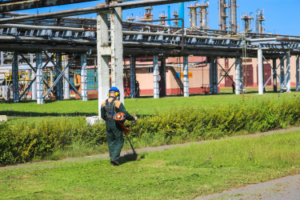As a landlord, you have a lot of responsibilities. Not only do you have to make sure that your tenants are happy, you also have to ensure that you meet specific standards and regulations to ensure that your properties are habitable for your tenants.
In this blog, we will explore the main safety and habitability standards that landlords have to be aware of and comply with, and go into detail about the Housing Health and Safety Rating System, so you understand exactly what they are and why they are necessary.
What is the Housing Health and Safety Rating System (HHSRS)?
The Housing Health and Safety Rating System (HHSRS) is a check of any hazards that may be in your home that could affect your health. The checks are carried out by an Environmental Health Officer from the local council. The HHSRS was established as the statutory assessment criterion within the Housing Act 2004 (part 1).
If serious problems are located at the property, action will be taken. The types of action could include:
- Informal discussions with your landlord to carry out improvements
- Formal enforcement action against your landlord
The system is in place so that councils monitor the housing conditions for all private rented properties, council and housing association homes as well as owner occupied homes.
The Environmental Health Officer will determine whether there is a risk of harm due to any hazards. They will consider the likelihood of harm; how serious it would be and if there are any extra risks to children or older people. The hazards are categorised as category 1 (the most serious, usually resulting in action) or category 2 (less serious which might involve action being taken).
How often do I need to carry out a HHSRS inspection?
Environmental Health Officers have the right to inspect your properties at any time, however, there is no specified timeframe, and the landlord is not responsible for obtaining an inspection of this type. Tenants can contact their local authority if they believe that there are hazards at their property and that their home is not fit for human habitation.
What is the difference between an Environmental Health House inspection and a HHSRS inspection?
An Environmental Health House inspection is another name for an HHSRS inspection. As the checks are carried out by Environmental Health Officers, the former name is often used. The inspection uses the Housing Health and Safety Rating System (HHSRS) rating system to identify the severity of the hazards and risks involved.
Fitness for Human Habitation Act 2018
This legislation came into force on 20 March 2019 and is designed to ensure that property which is rented out is fit for human habitation. It also strengthens tenants’ rights if a landlord doesn’t fulfil their obligations to keep a property safe.
This legislation also amended the Landlord and Tenant Act 1985 by requiring landlords to ensure that their properties are fit for human habitation at the beginning of a tenancy and throughout it.
What are the criteria to decide if a property is fit for human habitation?
The criteria used are set out in section 1- of the Landlord and Tenant Act 1985. These are whether:
- the building has been neglected and is in a bad condition
- the building is unstable
- there’s a serious problem with damp
- it has an unsafe layout
- there’s not enough natural light
- there’s not enough ventilation
- there is a problem with the supply of hot and cold water
- there are problems with the drainage or the lavatories
- it’s difficult to prepare and cook food or wash up
- or any of the 29 hazards set out in the Housing Health and Safety (England) Regulations 2005
Examples of Category 1 Hazard housing
There are two categories of hazard, with category 1 being the most serious and most likely to cause significant harm or even death. There are 29 hazards which must be considered, and these are divided into four groupings: Physiological, Psychological, Protection against infection and Protection against accidents. The system is concerned with the likelihood that the risk might lead to disease, infirmity, physical injury, and the level of mental disorder and distress caused.
The category 1 hazards most likely to exist in properties are:
- Damp and mould growth
- Excess cold
- Crowding and space
- Entry by intruders
- Falling on level surfaces etc.
- Falling on stairs etc.
- Fire
Health and safety in the home
As stated above, landlords have responsibilities to ensure that their properties are free from hazards. They must also ensure that relevant safety standards and regulations are met on an ongoing basis. Some of these include:
Gas Safety
A Landlord’s Gas Safety Record must be provided to tenants on an annual basis. This check is carried out by a registered Gas Safe engineer and will check all gas appliances at the property. New tenants must be given sight of the LGSR, and existing tenants within 28 days of the annual check.
There is also a legal requirement to fit a carbon monoxide alarm in every room which contains gas appliances (excluding gas cookers).
Electrical Safety
Properties should be issued with an Electrical Installation Condition Report (EICR) every five years. A qualified electrical engineer will visually inspect the installation for damage and run checks on circuits and examine plugs, sockets, light switches and the fuse box. Similarly to a LGSR, the EICR must be shown to new tenants before occupation and existing tenants within 28 days of the report.
Fire Safety
Smoke alarms should be fitted and connected to a power supply, with back-up batteries. If there are open fires or wood-burners at the property, it is recommended that the chimney is swept regularly, and there is a legal requirement to fit a carbon monoxide detector provided.
Following the Grenfell Fire incident, further rules were introduced in June 2022 banning combustible cladding to accommodation over 18 metres in height.
Furniture and appliances
Where furniture and appliances are provided at a property, they must adhere to the relevant safety standards. Soft furnishings, for example, must meet fire safety standards and display relevant manufacturer labels to this effect. Whilst not law, it is good practice to have electrical appliances checked regularly to ensure there are no faults and should be professionally repaired or replaced if there are. Portable Appliance Testing (PAT) can be carried out by a qualified electrician who will issue a PAT certificate to confirm that all items are safe.
Energy efficiency standards
In 2018 rented properties were required to have an Energy Efficiency rating of band E as a minimum, but with new regulation, this will move to a requirement of band C for any new tenancies from 2025 and all tenancies from 2028.
Legionella Risk Assessment
There isn’t a requirement to record the findings of a risk assessment, but the Health and Safety Executive recommends that this is good practice. Landlords are obliged to carry out a Legionella Risk Assessment before letting a property.
How Dependable can help landlords
Dependable offer a range of hard and soft facility management and property services that will make sure your property is well looked after. With a large team of experts, you can depend on Dependable to keep your property in the best state possible.
Contact us today to find out more.




